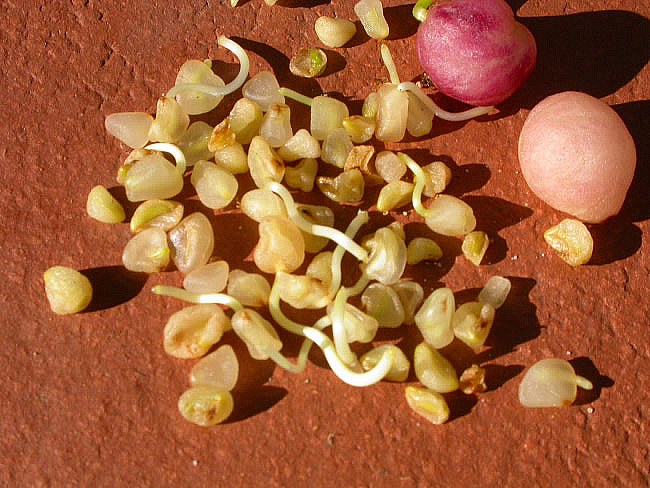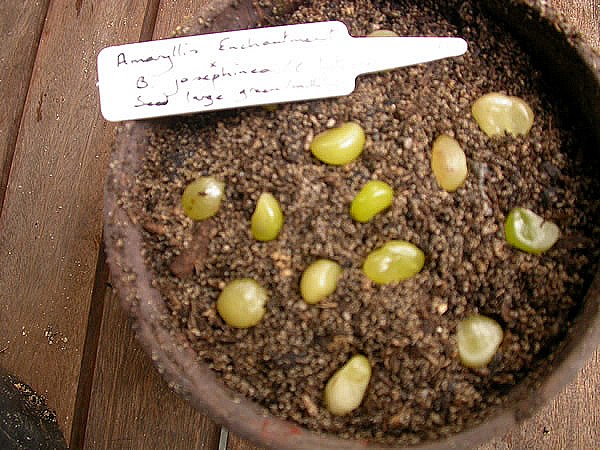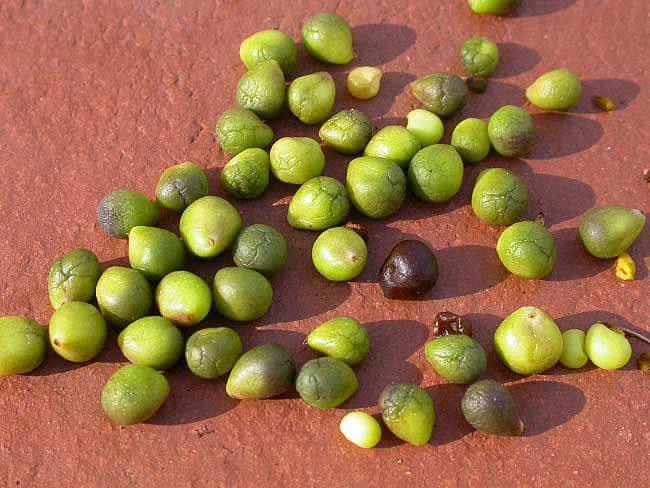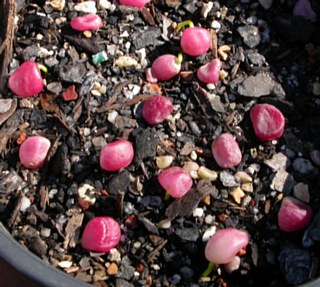1. Amaryllis x multiflora 'Rosea' X B. josephinae = many small transparent white seed which do germinate
strongly despite being about 1/6 to 1/8th the volume of a normal Amaryllis
seed - sometimes with two to three natural sized seed but outnumbered by
many (up to 60) pure small transparent seed -- same result with around 10
fruits on 4 different bulbs

2. Amaryllis x multiflora 'alba' X B. josephinae = lightly pinkish seed about 1/2 size of normal Amaryllis occasionally a few small white seeds amongst the pink.
3. Amaryllis x multiflora 'Center pink Stripe var' X B. josephinae = many small transparent white seed as per 1.
4. Amaryllis 'Enchantment' X B. josephinae = all seed were a little larger than
natural size and very green in colour - occasionally one to two light
pink or white seed.

The Amaryllis that I have labeled as 'alba' is a white flowered seedling of 'Hathor' sold commercially as 'Hathor'.
The reverse crosses with Brunsvigia josephinae as the seed parent with various colour forms of Amaryllis x multiflora also had one baffling result:
5. Brunsvigia josephinae x Amaryllis x multiflora (all varieties) resulted in seed with green-bronze to green-maroon colours, the normal colour of Brunsvigia josephinae seed.
6. Brunsvigia josephinae x Amaryllis 'Enchantment' resulted in mainly greenish
coloured seed, a few green—light bronze seed and the occasional a very
dark maroon seed
 .
.
Presumably if the latter seedlings grow to maturity is it likely that they would result in mainly white flowered Amarygias with a couple of pinks/lavender and one possible dark red? The cross with 'Enchantment' was the only one to produce the occasion dark seed.
The seed from the Amaryllis seed parents appeared very slow to develop — taking around 8 to 10 weeks to mature, whereas the Brunsvigia seed was mature within 4 weeks.
I was proceeding on the assumption that the x multiflora hybrids were probably originally created using B. grandiflora as the pollen parent. Whereas Amaryllis 'Enchantment' does carry some B. josephinae genes. Have there been results like this in the past when Amaryllis breeders have tried to create Amarygias.
I've read much of Les Hannibal's writings about Amarygia breeding but I didn't find any articles by him on the eventual outcomes of his breeding using Brunsvigia as pollen and seed parents.
Do you have any ideas why a white Amaryllis crossed with B. josephinae are likely to produce coloured Amarygias, while rosy pink Amaryllis crossed with B. josephinae appear likely to produce white coloured Amarygias?
There may be members with the experience of creating Amarygias who might know if my assumptions are correct. What broadly is likely to be happening genetically in terms of flower colour?
I have attached two seed images to better indicate the seed outcomes — one is of the A. multiflora 'alba' x B. josephinae and the other is the B. josephinae x A. 'Enchantment'.
Cheers

